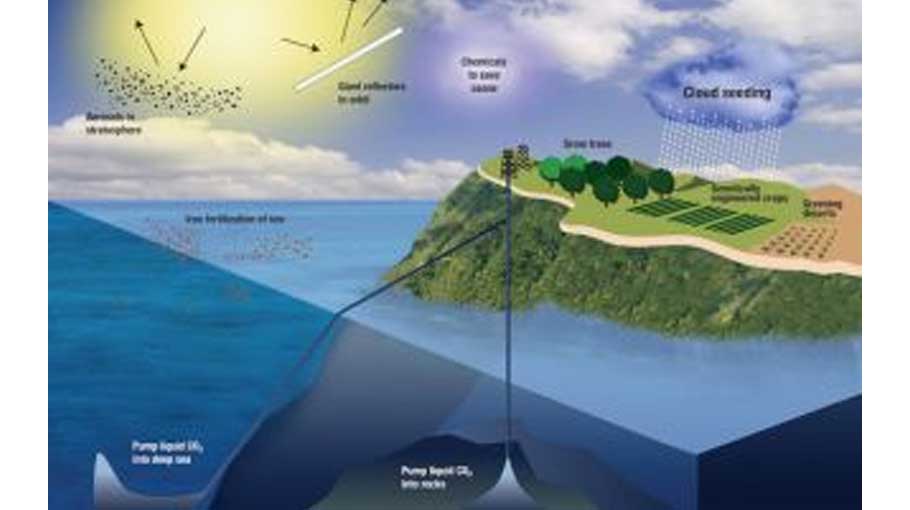Geoengineering to mitigate the effects of climate change

Gernot Wagner, Project Syndicate
There ultimately is no way to stabilize the climate without addressing the fact that humans are emitting far too much carbon dioxide into the atmosphere, year after year.
But cutting emissions is not the only response to the climate crisis, nor was it the one that scientists proposed over half a century ago in the first-ever government report on climate change.
Economic activity produces emissions that drive up atmospheric concentrations, which in turn increases temperatures, thereby creating new conditions that are damaging to human welfare. Whereas cutting carbon dioxide and other greenhouse-gas emissions addresses the first part of the chain, climate adaptation concerns the latter end — from changing temperatures to the impact on society.
But the tail end should not necessarily come last in the sequence of our response. If anything, we should have introduced more aggressive adaptation measures a long time ago.
This delay owes much to a previous, longstanding fear among environmentalists that the mere mention of adaptation would undermine the primary aim of cutting carbon emissions. According to this argument, adaptation would create a “moral hazard”: the idea that insulating people from the consequences of their actions will lead them to engage in even riskier behavior (think seat belts or condoms).
But mitigation and adaptation do not exhaust all the options. Carbon removal specifically breaks the second link in the chain, from emissions to concentrations. Technically, emissions could stay the same, while removal sucks enough carbon out of the atmosphere to decrease concentrations, lessening the net effect and giving rise to many a “net-zero” climate commitment.
Read More: Cumilla incident and its consequence
That sounds like a win-win. But it turns out to be a rather expensive proposition, especially when looking beyond trees and other “nature-based” solutions. While these remove carbon from the atmosphere, they retain it in the biosphere and are vulnerable to deforestation and natural disasters alike. Other more high-tech methods could put carbon back into the geosphere, storing it permanently underground (from where it came before it was burned as fossil energy).
As with adaptation in earlier decades, the prospect of carbon removal brings moral hazard to the fore, raising many difficult political questions. With so many opportunities for mitigation available, can we really justify subsidies for expensive carbon-removal technologies? Moreover, why should big polluters be let off the hook?
That second question goes to the heart of many political debates around climate and economic policy more broadly. Is climate change caused by too much pollution, or is it a problem of economic growth itself? Those who believe it is the latter argue for a full-scale reining in — or rechanneling — of economic activity and market forces; some even call for “degrowth” and other more sweeping societal transformations. Given these associations, it is easy to see why those on the left would be suspicious of carbon removal and why those on the right might be eager to embrace it.
Some describe this scale of geoengineering as a “last-ditch” option that should be reserved only for a planetary emergency. Others emphasize that it should be viewed only as a potential complement to serious emissions reductions and other interventions — from adaptation to carbon removal — with each addressing climate risks differently. But, again, those who merely argue for more research into solar geoengineering usually meet with strident “moral-hazard” objections, as if simply studying the issue will distract from emissions cuts. We must move beyond that argument. Remember, adaptation measures used to be viewed the same way.
Regardless of whether one believes that solar geoengineering is inherently dangerous, potentially useful, or both, one should support more careful, open and transparent research into the matter. We are not in a position where we can peremptorily reject potential solutions to the climate crisis. If nothing else, geoengineering research could help to educate those who are still dragging their feet on emissions reductions.
After all, by failing to break the other links in the climate chain, we are making it more likely that either carbon removal or solar geoengineering will become a key element in the 21-century climate-policy portfolio — whether one likes it or not.
Gernot Wagner, clinical associate professor of environmental studies at New York University, is author of the forthcoming “Geoengineering: The Gamble” (Polity, 2021).© Project Syndicate, 2021.
Source: Project Syndicate
Related News:




